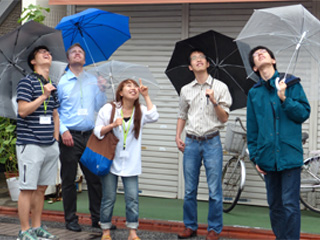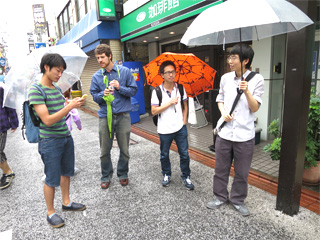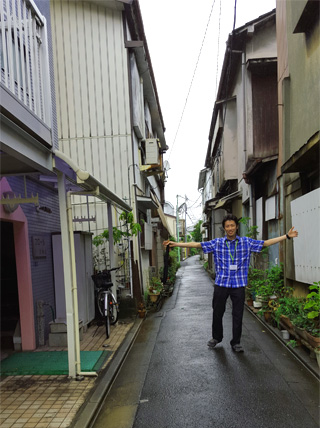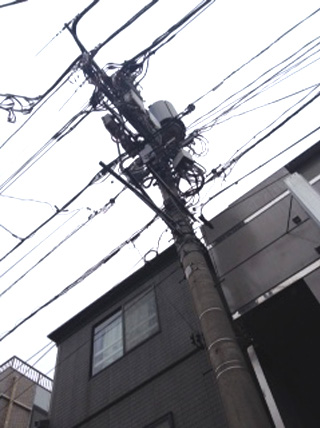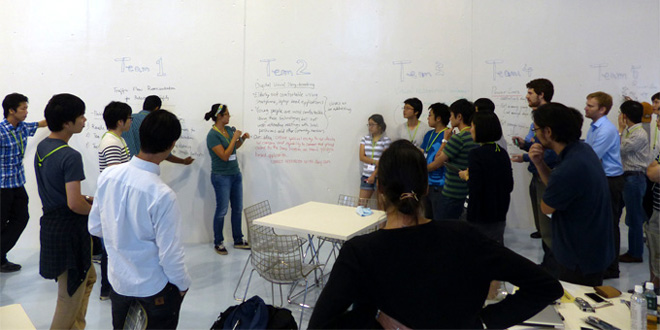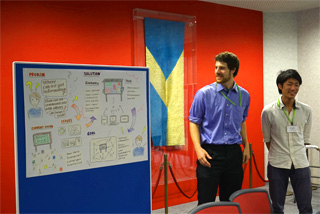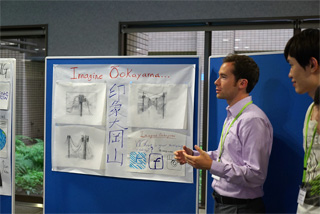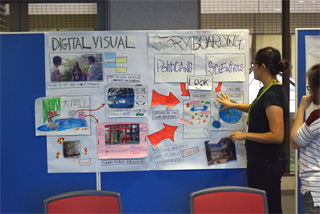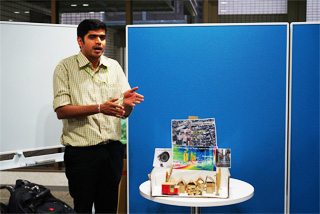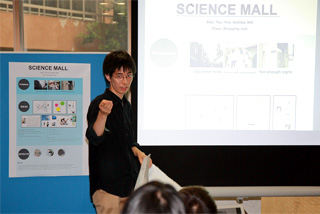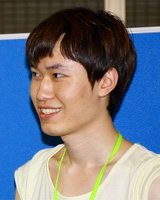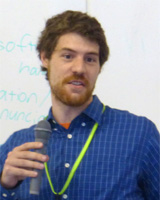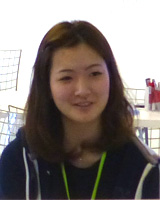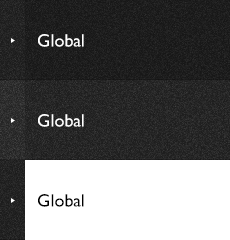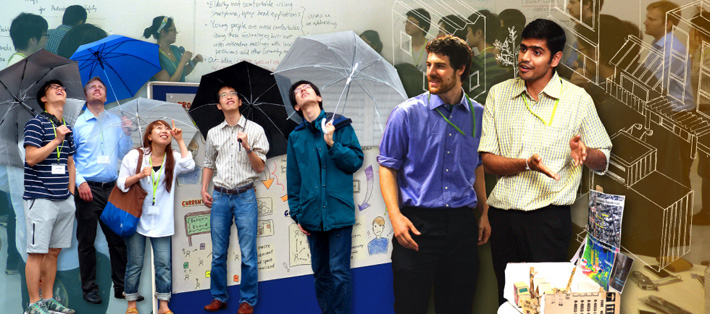
Five days of joint activities
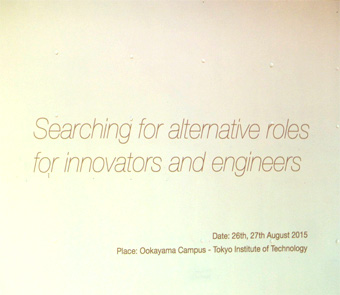
Innovation has brought with it the democratization of knowledge and technology, yet members of the general public feel excluded from decision-making that often directly affects their lives. With societal betterment and interaction one of the cornerstones of Tokyo Tech's ideology, the Institute hosted a student workshop with engineering students from UC Santa Barbara (UCSB) in late August 2015 to address how to effectively share scientific expertise with the public and cooperate with communities to solve local problems.
Held from August 24 to 28 in conjunction with the Tokyo Tech-UC Santa Barbara Joint Symposium, the workshop gave students the chance to develop mutual understanding through five days of joint activities. After company visits to Nissan Motor Co., Ltd. and the Port and Airport Research Institute, students gathered at Tokyo Tech on Day 3 to discuss the potential of design processes for engaging communities in collaborative projects.
- Tokyo Tech-UC Santa Barbara student workshop (August 24-28)
-
Day 1: UCSB students arrive in Japan, presentations by Tokyo Tech master's students
Day 2: Visits to Nissan Motor Co., Ltd. and Port and Airport Research Institute
Day 3: Session One of collaborative work at Tokyo Tech's Centennial Hall
Day 4: Session Two of collaborative work, joint presentations, lab visits
Day 5: Field meetings and lab visits
Searching for alternatives using expertise from different areas
"Searching for alternative roles for innovators and engineers" brought together thirteen students from Tokyo Tech, five from UCSB, and five artists including three University of the Arts London students. Leading the workshop and discussions were Tokyo Tech lecturer Ryo Terui and Dr. Peter Thornton from Chuo University.
The core objectives were to explore new approaches to engineering and design, and to reconsider the roles and positions of engineers in society. Students were asked to go out into the local neighborhood around the Ookayama Campus to identify problems and potential solutions together with the community, in an attempt to democratize the design process and open up the act of innovation to users themselves. Ultimately, teams were asked to present their solutions in a visual language accessible to the non-specialist public.
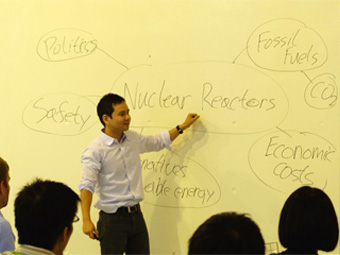 Dr. Peter Thornton leading the introductory brainstorming
Dr. Peter Thornton leading the introductory brainstorming
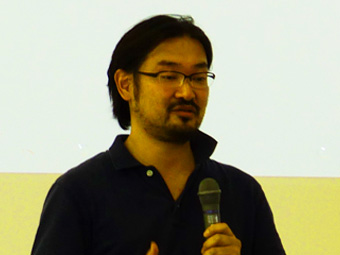 Lecturer Ryo Terui explaining public engagement
Lecturer Ryo Terui explaining public engagement
with the use of visuals
Identifying problems in the local community
The workshop began with an introductory lecture highlighting the social contexts surrounding innovation and industrialization in the 20th century. Discussion focused on how innovation and design emerge in relation to political, cultural, and economic factors, and how difficult issues such as nuclear power and vaccinations often distance experts from non-experts, or authorities from inhabitants. Recent developments in social design that explore the potential of design processes for supporting and engaging communities in collaborative projects were also introduced.
Students then formed teams and went to explore the neighborhood. Teams were encouraged to talk to members of the public regarding local problems, with the goal of inspiring the community to take ownership of the innovative process.
…and identifying problems.
By the time the teams regrouped in the afternoon to share their ideas, five communal issues in the Ookayama neighborhood had been identified:
- No centralized information areas in the community
- Aesthetically disapproving and potentially unsafe power lines
- Lack of communication between generations
- Congested roads and unsafe conditions for pedestrians
- Lack of communication between community and university
Teams sharing their initial thoughts on local issues
Visually accessible storyboards
In Session Two, students gathered again at the Ookayama Campus to go through the actual visualization process of their ideas. At this stage, the art students took the roles of visual facilitators, helping Tokyo Tech and UCSB students translate their engineering processes into visually accessible storyboards. The main aim of this session was to enable collaboration with visual art students and to convey concepts and messages through visualization, rather than simply pursue the quality of outcomes.
Some chose to create designs using photos and freehand art, others opted for 3D structures. Teams shared their proposed solutions at a plenary discussion session on the afternoon of the 27th.
Team One proposed the installation of an interactive bulletin board where communal information is shared and centralized.
Team Two proposed the undergrounding of power lines and transformers for improved safety and aesthetics, not just in central Tokyo but in residential areas like Ookayama.
Team Three suggested providing local residents with easy access to an interface where suggested communal improvements are shared with politicians and scientists.
Team Four recommended the implementation of an infra-red detection system to ease traffic congestion and improve pedestrian safety on the narrow neighborhood streets.
Team Five's proposal was an information hub integrated with a shopping mall, where the latest information on science and technology is disseminated to all generations.
The day ended with a discussion on what it means to be an authority in a certain field, and the need for engineers, scientists, and society as a whole to understand the potentially undesirable effects of democratizing knowledge and technology.
Comments from participating students
- Xusheng Zhang
Tokyo Tech
First-year master's student, Communication and Computer Engineering
-
This workshop made me think more deeply about the engineer's position in society, and the paradox of positive and negative effects of technology. I realized how important it is to show the public the meaning of my research. I had always worked with students from the engineering and science fields, so transforming the technical sense into the visual sense with art students was very challenging. It was great to work with people from other countries and cultures. I feel it always improves me, it expands my thinking and way of doing things. It gives me more choice in what kind of person I can be.
- Rob Maurer
UC Santa Barbara
Fourth-year doctoral student, Electrical and Computer Engineering
-
Aside from the exchange in cultural ideas, this workshop was about challenging us to step out from our normal way of thinking. The interdisciplinary nature, the need to think in a specific style, made us all look at how our work as engineers impacts society in a broader sense, and find better ways to involve society in our research. We were asked to find a problem in a community which for me was very foreign, and propose a solution to that problem. It was really cool to get a chance to work with graphic designers and other specialists, and try to use our individual talents to work towards a single purpose.
- Eiko Mitsui
University of the Arts London
First-year bachelor's student
-
I had never worked with students from Japanese universities, let alone sci-tech universities, so it was really inspiring to learn about other students' ideas and what they are actually aiming for in the future. Our group decided to devise a 3D structure to visualize our ideas for improving the local community, which was a real challenge in the time provided. The combination of art and science was a very new experience for me, and I would love to explore workshops like this in the future as they obviously generate new ideas and discoveries.
Multiple perspectives converge
In addition to being a unique science communication workshop bringing together students from three universities, this was also Tokyo Tech's first collaborative student workshop with UCSB. With multiple perspectives from a diverse group of students converging at the same table, the workshop was a fruitful exercise in thinking outside the box, engaging the public, and designing solutions to real-life problems.
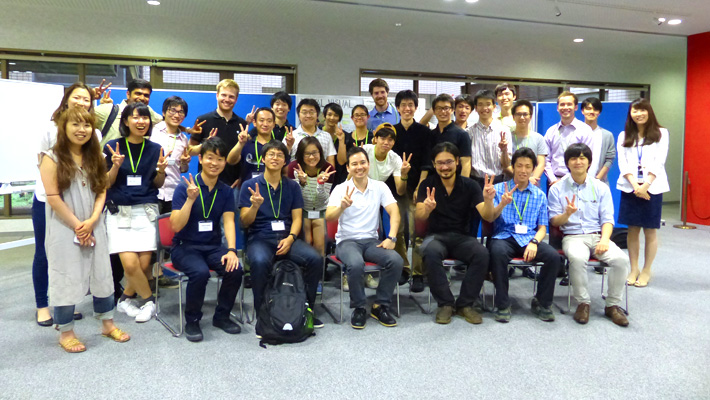 All smiles at the end of Session Two
All smiles at the end of Session Two
This workshop was organized by Tokyo Tech's Dr. Hirofumi Saito and Assistant Professor Hirotoyo Nakashima.
The Special Topics component of the Tokyo Tech Website shines a spotlight on recent developments in research and education, achievements of its community members, and special events and news from the Institute.
Past features can be viewed in the Special Topics Gallery.
Published: January 2016
. Any information published on this site will be valid in relation to Science Tokyo.






